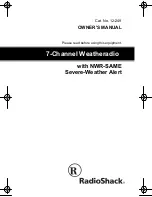
TK-8360/8360H/8360H
(
U
)
16
5-1. Memory Circuit
The transceiver has a 512k-bit EEPROM (IC705). The EE-
PROM contains adjustment data. The MCU (IC704) controls
the EEPROM through three serial data lines.
EEPC
IC704
MCU
IC705
EEPROM
EEPD
EEPS
EEPQ
Fig. 11 Memory circuit
5-2. Display Circuit
The MCU (IC704) controls the LCD display and LEDs.
When power is on, the MCU will use the MBL line and
the BLC line to control the key backlight LEDs and LCD
backlight LEDs.
When the transceiver is busy, the GLED line goes high,
Q6 turns on and the green LED (D23) lights after Q5 turns
on. In transmit mode, the RLED line goes high, Q3 and Q4
turn on and the red LED (D23) lights.
BLED will be set high when the function select (FPU set-
ting) is on, Q2 turns on and the blue LED (D22) lights.
The LCD driver (IC1) controls the functions of the LCD
through the LCDDI, LCDDO, LCDCL, LCDCE lines from the
MCU.
Q8
SW
Q7
SW
D5~D9
Key backlight
LCD
Display
IC704
MCU
IC1
LCD
driver
LCDDI
LCDDO
LCDCL
LCDCE
MBL
Q10
SW
Q9
SW
LCD backlight
BLC
Q6
SW
Q5
SW
D23
GLED
Q3
SW
Q4
SW
RLED
Q2
SW
D22
BLED
Fig. 12 Display circuit
5-3. Key Matrix Circuit
The front panel has function keys. Each of them is con-
nected to a cross point of a matrix of the KMI1 to KMO3
ports of the LCD driver. The KMO1 to KMO3 ports are al-
ways high, while the KMI1 to KMI3 ports are always low.
The LCD driver monitors the status of the KMI1 to
KMO3 ports. If the state of one of the ports changes, the
LCD driver assumes that the key at the matrix point corre-
sponding to that port has been pressed.
IC1
LCD
driver
KMO1
KMO2
KMO3
KMI3
KMI2
KMI1
B
VOL DN
CH DN
A
■
CH UP
S
C
VOL UP
Fig. 13 Key matrix circuit
6. Signaling Circuit
6-1. Encode
■
Low-speed data (QT, DQT)
Low-speed data is output from pin 26 (LSDO) of the
MCU (IC704). The signal passes through a low-pass CR
fi lter. The signal is mixed with the audio signal and goes to
the VCO and TCXO (X1) modulation input after signal pro-
cessing in the baseband IC (IC702).
■
High-speed data (2-tone)
High-speed data (HSD) is output from pin 2 (HSDO) of
the MCU.
The signal passes through a low-pass CR fi lter. TX devia-
tion making an adjustment by MCU is applied to the base-
band IC (IC702). The signal is mixed with the audio signal
and goes to the VCO and TCXO.
The RX tone is audio output of the baseband IC (IC702)
at the same time to audio power amplifi er and then to the
speaker.
X1
TCXO
VCO
IC702
Baseband IC
DTMF/
MSK
IC2
PLL
TCXO
MOD
VCO
MOD
QT/DQT
LSDO
2-TONE
HSDO
IC704
MCU
Fig. 14 Encode
■
MSK / DTMF
MSK and DTMF signal is self generated by the baseband
IC (IC702).
The TX deviation adjustment is done by the output gain
of the baseband IC (IC702), and is routed to the VCO. When
encoding MSK/DTMF, the microphone-input signal is muted.
6-2. Decode
■
Low-speed data (QT, DQT)
The demodulated signal from the FM IC (IC500) will input
to the baseband IC (IC702) to remove frequencies of 300Hz
or more.
The signal is input to pin 88 (LSDI) of the MCU. The
MCU digitizes this signal, performs processing such as DC
restoration, and decodes the signal.
CIRCUIT DESCRIPTION
TENTATIVE
















































